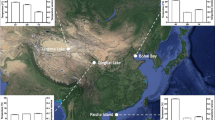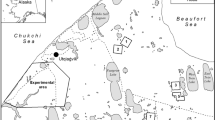Abstract
We tested three hypotheses of clutch size variation in two subspecies of the swamp sparrow (Melospiza georgiana georgiana and M. g. nigrescens). Swamp sparrows follow the pattern of other estuarine endemics, where clutch size is smaller among tidal salt marsh populations (M. g. nigrescens) than their closest inland relatives (M. g. georgiana). Our results support predation risk and temperature, but not adult survival, as explanations of this pattern in swamp sparrows. Coastal nests were twice as likely to fail as inland nests, and parental activity around the nest site was positively related to clutch size at both sites. When brood size was controlled for, coastal adults visited nests less often and females vocalized less frequently during visits than inland birds, which may decrease nest detectability to predators. Coastal parents waited longer than inland birds to feed offspring in the presence of a model nest predator, but there was no difference in their response to models of predators of adults, as would be expected if coastal birds possessed increased longevity. Additionally, coastal females laid more eggs than inland females over a single season, following a within-season bet-hedging strategy rather than reducing within-season investment. Coastal territories experienced ambient air temperatures above the physiological zero of egg development more often, and higher temperatures during laying correlated with smaller clutches and increased egg inviability among coastal birds. Similar effects were not seen among inland nests, where laying temperatures were generally below physiological zero. Both subspecies showed an increase in hatching asynchrony and a decrease in apparent incubation length under high temperatures. Coastal individuals, however, showed less hatching asynchrony overall despite higher temperatures. Both air temperatures during laying and predation risk could potentially explain reduced clutch size in not only coastal plain swamp sparrows, but also other tidal marsh endemics.











Similar content being viewed by others

References
Ardia DR, Cooper CB, Dhondt AA (2006) Warm temperatures lead to early onset of incubation, shorter incubation periods and greater hatching asynchrony in tree swallows Tachycineta bicolor at the extremes of their range. J Avian Biol 37:137–142
Ashmole NP (1963) The regulation of numbers of tropical oceanic birds. Ibis 103:458–473
Atlantic Coast Observer Network (2006) ACON data files. The John Hopkins University applied physics laboratory. Available at: http://www.jhuapl.edu/weather/education/ACONdata.html
Beadell J, Greenberg R, Droege S, Royle JA (2003) Distribution, abundance, and habitat affinities of the coastal plain swamp sparrow. Wilson Bull115:38–44
Cooper CB, Hochachka WM, Butcher G, Dhondt AA (2005) Seasonal and latitudinal trends in clutch size: thermal constraints during laying and incubation. Ecology 86:2018–2031
Cooper CB, Hochachka WM, Phillips TB, Dhondt AA (2006) Geographical and seasonal gradients in hatching failure in Eastern Bluebirds, Sialia sialis, reinforce clutch size trends. Ibis 148:221–230
Deeming DC, Ferguson MWJ (1992) Physiological effects of incubation temperature on embryonic development in reptiles and birds. In: Deeming DC, Ferguson MWJ (eds) Egg incubation: its effects on embryonic development in birds and reptiles. Cambridge University Press, Cambridge, pp 143–173
Eggers S, Griesser M, Ekman J (2005) Predator-induced plasticity in nest visitation rates in the Siberian jay (Perisoreus infaustus). Behav Ecol 16:309–315
Eggers S, Griesser M, Nystrand M, Ekman J (2006) Predation risk induces changes in nest-site selection and clutch size in the Siberian jay. Proc R Soc Lond B Biol Sci 273:701–706
Etterson MA, Nagy LR, Robinson TR (2007) Partitioning risk among different causes of nest failure. Auk 124:432–443
Fenwick GH, Boone DD (1984) The peatlands of western Maryland. In: Threatened and endangered plants and animals of Maryland. Maryland Department of Natural Resources, Natural Heritage Program, Annapolis
Ferretti V, Llambias PE, Martin TE (2005) Life-history variation of a neotropical thrush challenges food limitation theory. Proc R Soc Lond B Biol Sci 272:769–773
Fontaine JJ, Martin TE (2006) Parent birds assess nest predation risk and adjust their reproductive strategies. Ecol Lett 9:428–434
Ghalambor CK, Martin TE (2000) Parental investment strategies in two species of nuthatch vary with stage-specific predation risk and reproductive effort. Anim Behav 60:263–267
Ghalambor CK, Martin TE (2001) Fecundity-survival trade-offs and parental risk-taking in birds. Science 292:494–497
Ghalambor CK, Martin TE (2002) Comparative manipulation of predation risk in incubating birds reveals variability in the plasticity of responses. Behav Ecol 13:101–108
Gowaty PA, Plissner JH (1997) Breeding dispersal of eastern bluebirds depends on nesting success but not on removal of old nests: An experimental study. J Field Ornithol 68:323–330
Greenberg R (1989) Neophobia, aversion to open space, and ecological plasticity in song and swamp sparrows. Can J Zool 67:1194–1199
Greenberg RG et al (2006) Flooding and predation: trade-offs in the nesting ecology of tidal-marsh sparrows. In: Greenberg R, Maldonado JE, Droege S, McDonald MV (eds) Terrestrial vertebrates of tidal marshes: ecology, evolution, and conservation. Studies in avian biology, vol 32. Cooper Ornithological Society, Oshkosh, pp 96–109
Greenberg R, Droege S (1990) Adaptation to tidal marshes in breeding populations of the swamp sparrow. Condor 92:393–404
Greenwood PJ, Harvey PH (1982) The natal and breeding dispersal of birds. Annu Rev Ecol Syst 13:1–21
Haas CA (1998) Effects of prior nesting success on site fidelity and breeding dispersal: an experimental approach. Auk 115:929–936
Lack D (1948) The significance of clutch size. Part 3. Some interspecific comparisons. Ibis 90:25–45
Magrath RD et al (2000) Life in the slow lane: Reproductive life history of the White-browed Scrubwren, an Australian endemic. Auk 117:479–489
Martin TE (1995) Avian life-history evolution in relation to nest sites, nest predation, and food. Ecol Monogr 65:101–127
Martin TE (2002) A new view of avian life-history evolution tested on an incubation paradox. Proc R Soc Lond B Biol Sci 269:309–316
Martin TE (2004) Avian life-history evolution has an eminent past: does it have a bright future? Auk 121:289–301
Martin TE, Martin PR, Olson CR, Heidinger BJ, Fontaine JJ (2000) Parental care and clutch sizes in North and South American birds. Science 287:1482–1485
Mayfield HF (1975) Suggestions for calculating nest success. Wilson Bull 87:456–466
McDonald MV, Greenberg R (1991) Nest departure calls in female songbirds. Condor 93:365–373
Moreau RE (1944) Clutch size: a comparative study with reference to African birds. Ibis 86:286–347
Mowbray TB (1997) Swamp Sparrow (Melospiza georgiana). In: Poole A, Gill FB (eds) The birds of North America, vol 279. The Academy of Natural Sciences and The American Ornithologists’ Union, Philadelphia
Nolan PM, Stoehr AM, Hill GE, McGraw KJ (2001) The number of provisioning visits by House Finches predicts the mass of food delivered. Condor 103:851–855
O’Connor RJ (1984) The growth and development of birds. Wiley, Chichester
Powell LA, Frasch LL (2000) Can nest predation and predator type explain variation in dispersal of adult birds during the breeding season? Behav Ecol 11:437–443
Ricklefs RE (1967) A graphical method of fitting equations to growth curves. Ecology 48:978–983
Ricklefs RE (1970) Clutch size in birds: outcome of opposing predator and prey adaptations. Science 168:559–560
Rotella JJ, Dinsmore SJ, Shaffer TL (2004) Modeling nest-survival data: a comparison of recently developed methods that can be implemented in MARK and SAS. Anim Biodivers Conserv 27:187–205
SAS Institute (2005) The SAS system for windows: version 9.1. SAS Institute, Cary
Shaffer TL (2004a) Logistic-exposure analyses of nest survival (version 25 July 2006). Northern Prairie Wildlife Research Center Online, Jamestown. Available at: http://www.npwrc.usgs.gov/resource/birds/nestsurv/index.htm
Shaffer TL (2004b) A unified approach to analyzing nest success. Auk 121:526–540
Skutch AF (1949) Do tropical birds rear as many young as they can nourish? Ibis 91:430–455
Skutch AF (1976) Parent birds and their young. University of Texas Press, Austin
Slagsvold T (1982) Clutch size variation in passerine birds: the nest predation hypothesis. Oecologia 54:159–169
Slagsvold T (1984) Clutch size variation of birds in relation to nest predation: On the cost of reproduction. J Anim Ecol 53:945–953
Stoleson SH, Beissinger SR (1999) Egg viability as a constraint on hatching synchrony at high ambient temperatures. J Anim Ecol 68:951–962
Webb DR (1987) Thermal tolerance of avian embryos: a review. Condor 89:874–898
Winkler DW et al (2004) Breeding dispersal and philopatry in the tree swallow. Condor 106:768–776
Acknowledgments
The field research was funded by grants from the Delaware Division of Fish and Wildlife, the Maryland Ornithological Society, the Washington Biologists’ Field Club, the Washington Group of the Explorer’s Club, the Eastern Bird Banding Association, the Smithsonian Institution’s Abbot Fund, Virginia Tech’s Graduate Research Development Program, the Bailey Fund at Virginia Tech, and both Smithsonian Institution Graduate and Pre-doctoral Fellowships. Much thanks to Kevin Kalasz, Jennifer Wang, Meghan Powell, Kari Murabito, Jaan Kolts, Karen Callaway, Audrey Wessel, Joel Adamson, Benjamin Augustine, Benjamin Beas, Kate Heyden, and Irene Liu for help in the field. All research was compliant with current laws of the USA. Bird handling was conducted under US federal banding permit number 22665 and approved by the Conservation and Research Center Institutional Animal Care and Use Committee of the Smithsonian National Zoological Park under proposal #04–10. Comments from Craig Osenberg, Blair Wolf, and an anonymous reviewer greatly improved this manuscript.
Author information
Authors and Affiliations
Corresponding author
Additional information
Communicated by Blair Wolf.
Rights and permissions
About this article
Cite this article
Olsen, B.J., Felch, J.M., Greenberg, R. et al. Causes of reduced clutch size in a tidal marsh endemic. Oecologia 158, 421–435 (2008). https://doi.org/10.1007/s00442-008-1148-1
Received:
Accepted:
Published:
Issue Date:
DOI: https://doi.org/10.1007/s00442-008-1148-1



